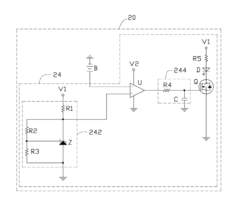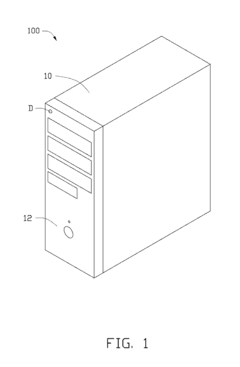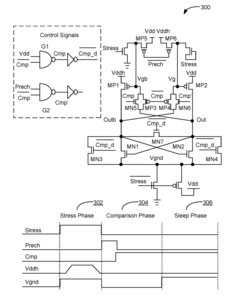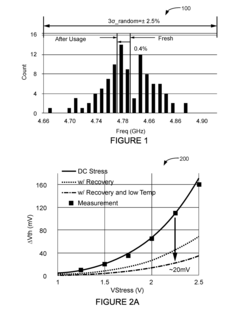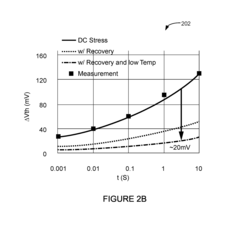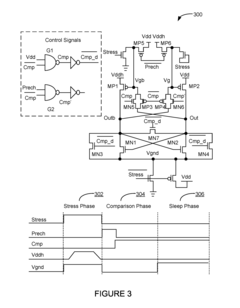Delving into CMOS Battery Contributions to Dynamic Network System Designs
JUL 22, 20259 MIN READ
Generate Your Research Report Instantly with AI Agent
Patsnap Eureka helps you evaluate technical feasibility & market potential.
CMOS Battery Evolution
The evolution of CMOS battery technology in dynamic network system designs has been a critical factor in shaping modern computing and networking infrastructures. Initially introduced in the 1980s, CMOS (Complementary Metal-Oxide-Semiconductor) batteries were primarily used to maintain basic system settings and real-time clock functions in personal computers. As network systems became more complex and dynamic, the role of CMOS batteries expanded significantly.
In the early 1990s, CMOS batteries began to play a crucial role in maintaining network configurations and security settings. This development was particularly important for enterprise-level systems, where consistent network parameters were essential for maintaining system integrity and security. The batteries ensured that critical network information, such as IP addresses, gateway settings, and access credentials, remained intact even when systems were powered down or disconnected from main power sources.
As we entered the 2000s, the increasing complexity of network architectures demanded more from CMOS batteries. They started to support advanced features like wake-on-LAN capabilities, remote management settings, and BIOS-level network boot options. This evolution allowed for more sophisticated network management and improved system recovery mechanisms in large-scale deployments.
The mid-2000s saw a shift towards more energy-efficient and longer-lasting CMOS battery designs. Lithium-ion technologies replaced older nickel-cadmium batteries, offering improved longevity and reliability. This advancement was crucial for maintaining the integrity of network configurations in always-on server environments and data centers, where system uptime is paramount.
In recent years, the role of CMOS batteries has further expanded to support dynamic network reconfiguration in virtualized environments. They now play a vital role in maintaining hypervisor settings and virtual machine configurations, enabling seamless migration and failover in cloud computing infrastructures. This evolution has been essential in supporting the agility and flexibility required in modern, software-defined networking environments.
The latest developments in CMOS battery technology focus on integration with advanced power management systems. These batteries now work in conjunction with intelligent power distribution units (PDUs) and uninterruptible power supplies (UPS) to ensure continuous operation of critical network components. This integration has become increasingly important in edge computing scenarios, where maintaining network connectivity and configuration in remote or challenging environments is crucial.
Looking forward, the evolution of CMOS batteries in network systems is likely to continue, with a focus on enhanced energy density, improved environmental sustainability, and tighter integration with emerging network technologies such as 5G and Internet of Things (IoT) infrastructures. As network systems become more distributed and autonomous, the role of CMOS batteries in maintaining system integrity and enabling rapid reconfiguration will only grow in importance.
In the early 1990s, CMOS batteries began to play a crucial role in maintaining network configurations and security settings. This development was particularly important for enterprise-level systems, where consistent network parameters were essential for maintaining system integrity and security. The batteries ensured that critical network information, such as IP addresses, gateway settings, and access credentials, remained intact even when systems were powered down or disconnected from main power sources.
As we entered the 2000s, the increasing complexity of network architectures demanded more from CMOS batteries. They started to support advanced features like wake-on-LAN capabilities, remote management settings, and BIOS-level network boot options. This evolution allowed for more sophisticated network management and improved system recovery mechanisms in large-scale deployments.
The mid-2000s saw a shift towards more energy-efficient and longer-lasting CMOS battery designs. Lithium-ion technologies replaced older nickel-cadmium batteries, offering improved longevity and reliability. This advancement was crucial for maintaining the integrity of network configurations in always-on server environments and data centers, where system uptime is paramount.
In recent years, the role of CMOS batteries has further expanded to support dynamic network reconfiguration in virtualized environments. They now play a vital role in maintaining hypervisor settings and virtual machine configurations, enabling seamless migration and failover in cloud computing infrastructures. This evolution has been essential in supporting the agility and flexibility required in modern, software-defined networking environments.
The latest developments in CMOS battery technology focus on integration with advanced power management systems. These batteries now work in conjunction with intelligent power distribution units (PDUs) and uninterruptible power supplies (UPS) to ensure continuous operation of critical network components. This integration has become increasingly important in edge computing scenarios, where maintaining network connectivity and configuration in remote or challenging environments is crucial.
Looking forward, the evolution of CMOS batteries in network systems is likely to continue, with a focus on enhanced energy density, improved environmental sustainability, and tighter integration with emerging network technologies such as 5G and Internet of Things (IoT) infrastructures. As network systems become more distributed and autonomous, the role of CMOS batteries in maintaining system integrity and enabling rapid reconfiguration will only grow in importance.
Network System Demand
The demand for dynamic network systems has been steadily increasing in recent years, driven by the growing complexity and scale of modern computing environments. These systems require robust and flexible power management solutions to ensure continuous operation and optimal performance. CMOS batteries play a crucial role in this context, providing backup power for critical system components and maintaining essential settings during power interruptions.
In enterprise environments, the need for reliable network systems is paramount. Large-scale data centers, cloud computing infrastructures, and distributed computing networks all rely on uninterrupted power supply to maintain data integrity and system availability. The integration of CMOS batteries into these systems addresses the challenge of preserving configuration settings and real-time clock information during power outages or system resets, ensuring rapid recovery and minimal downtime.
The Internet of Things (IoT) has further amplified the demand for dynamic network systems capable of supporting a vast array of connected devices. As IoT deployments expand across various sectors, including smart cities, industrial automation, and healthcare, the requirement for power-efficient and resilient network infrastructures becomes more pronounced. CMOS batteries contribute to the stability of these systems by maintaining critical data and enabling quick device initialization, even in scenarios with intermittent power availability.
Edge computing represents another significant driver of network system demand. As processing capabilities move closer to data sources, the need for reliable power management at distributed network nodes increases. CMOS batteries in edge devices help maintain local configurations and support rapid boot-up processes, enabling seamless operation in diverse environmental conditions.
The telecommunications sector, particularly with the ongoing rollout of 5G networks, presents a substantial market for dynamic network systems. Base stations and network equipment require robust power backup solutions to ensure continuous connectivity. CMOS batteries play a vital role in preserving network configurations and supporting quick recovery during power fluctuations, contributing to the overall reliability of telecommunications infrastructure.
In the automotive industry, the rise of connected and autonomous vehicles has created a new frontier for network system demand. These vehicles rely on complex onboard networks and require persistent storage of critical parameters. CMOS batteries support the retention of vehicle settings, security credentials, and system states, ensuring seamless operation and enhancing user experience.
As organizations increasingly adopt hybrid and multi-cloud architectures, the demand for flexible and resilient network systems continues to grow. These complex environments require sophisticated power management solutions to maintain consistency across diverse infrastructure components. CMOS batteries contribute to the seamless integration and operation of these heterogeneous systems by preserving essential configuration data across different cloud platforms and on-premises infrastructure.
In enterprise environments, the need for reliable network systems is paramount. Large-scale data centers, cloud computing infrastructures, and distributed computing networks all rely on uninterrupted power supply to maintain data integrity and system availability. The integration of CMOS batteries into these systems addresses the challenge of preserving configuration settings and real-time clock information during power outages or system resets, ensuring rapid recovery and minimal downtime.
The Internet of Things (IoT) has further amplified the demand for dynamic network systems capable of supporting a vast array of connected devices. As IoT deployments expand across various sectors, including smart cities, industrial automation, and healthcare, the requirement for power-efficient and resilient network infrastructures becomes more pronounced. CMOS batteries contribute to the stability of these systems by maintaining critical data and enabling quick device initialization, even in scenarios with intermittent power availability.
Edge computing represents another significant driver of network system demand. As processing capabilities move closer to data sources, the need for reliable power management at distributed network nodes increases. CMOS batteries in edge devices help maintain local configurations and support rapid boot-up processes, enabling seamless operation in diverse environmental conditions.
The telecommunications sector, particularly with the ongoing rollout of 5G networks, presents a substantial market for dynamic network systems. Base stations and network equipment require robust power backup solutions to ensure continuous connectivity. CMOS batteries play a vital role in preserving network configurations and supporting quick recovery during power fluctuations, contributing to the overall reliability of telecommunications infrastructure.
In the automotive industry, the rise of connected and autonomous vehicles has created a new frontier for network system demand. These vehicles rely on complex onboard networks and require persistent storage of critical parameters. CMOS batteries support the retention of vehicle settings, security credentials, and system states, ensuring seamless operation and enhancing user experience.
As organizations increasingly adopt hybrid and multi-cloud architectures, the demand for flexible and resilient network systems continues to grow. These complex environments require sophisticated power management solutions to maintain consistency across diverse infrastructure components. CMOS batteries contribute to the seamless integration and operation of these heterogeneous systems by preserving essential configuration data across different cloud platforms and on-premises infrastructure.
Current Challenges
The integration of CMOS batteries into dynamic network system designs presents several significant challenges that researchers and engineers must address. One of the primary obstacles is the limited energy capacity of CMOS batteries, which constrains the operational duration and functionality of network devices. This limitation becomes particularly acute in scenarios requiring extended periods of autonomous operation or in remote locations where frequent battery replacements are impractical.
Another critical challenge lies in the power management and energy efficiency of CMOS battery-powered systems. Balancing the need for high performance with low power consumption remains a complex task, especially in dynamic network environments where workload and connectivity requirements can fluctuate rapidly. Engineers must develop sophisticated power management algorithms and hardware designs to optimize energy utilization without compromising system responsiveness or reliability.
The environmental impact and sustainability of CMOS batteries in network systems also pose significant challenges. As the scale of network deployments continues to grow, concerns about battery disposal and recycling become increasingly pressing. Developing eco-friendly battery technologies and implementing effective recycling processes are crucial steps in addressing these environmental concerns.
Thermal management represents another substantial challenge in CMOS battery integration. The heat generated during battery operation and charging can affect the performance and lifespan of both the battery and surrounding components. This issue is particularly pronounced in compact or densely packed network devices, where thermal dissipation is inherently limited.
Compatibility and standardization across different network systems and devices present ongoing challenges. The diversity of CMOS battery specifications and form factors can lead to integration difficulties and increased costs for manufacturers and end-users. Establishing industry-wide standards for CMOS batteries in network applications could alleviate these issues but requires significant coordination and consensus among stakeholders.
Security concerns also emerge as a critical challenge in CMOS battery-powered network systems. The potential for malicious actors to exploit battery-related vulnerabilities, such as power analysis attacks or intentional battery depletion, necessitates robust security measures. Developing secure battery management systems and protocols is essential to protect sensitive network infrastructure from these emerging threats.
Lastly, the scalability of CMOS battery solutions in large-scale network deployments presents a formidable challenge. As networks grow in size and complexity, managing and maintaining a vast number of battery-powered devices becomes increasingly difficult. Innovative approaches to battery monitoring, replacement logistics, and remote management are necessary to ensure the efficient operation of extensive network infrastructures relying on CMOS batteries.
Another critical challenge lies in the power management and energy efficiency of CMOS battery-powered systems. Balancing the need for high performance with low power consumption remains a complex task, especially in dynamic network environments where workload and connectivity requirements can fluctuate rapidly. Engineers must develop sophisticated power management algorithms and hardware designs to optimize energy utilization without compromising system responsiveness or reliability.
The environmental impact and sustainability of CMOS batteries in network systems also pose significant challenges. As the scale of network deployments continues to grow, concerns about battery disposal and recycling become increasingly pressing. Developing eco-friendly battery technologies and implementing effective recycling processes are crucial steps in addressing these environmental concerns.
Thermal management represents another substantial challenge in CMOS battery integration. The heat generated during battery operation and charging can affect the performance and lifespan of both the battery and surrounding components. This issue is particularly pronounced in compact or densely packed network devices, where thermal dissipation is inherently limited.
Compatibility and standardization across different network systems and devices present ongoing challenges. The diversity of CMOS battery specifications and form factors can lead to integration difficulties and increased costs for manufacturers and end-users. Establishing industry-wide standards for CMOS batteries in network applications could alleviate these issues but requires significant coordination and consensus among stakeholders.
Security concerns also emerge as a critical challenge in CMOS battery-powered network systems. The potential for malicious actors to exploit battery-related vulnerabilities, such as power analysis attacks or intentional battery depletion, necessitates robust security measures. Developing secure battery management systems and protocols is essential to protect sensitive network infrastructure from these emerging threats.
Lastly, the scalability of CMOS battery solutions in large-scale network deployments presents a formidable challenge. As networks grow in size and complexity, managing and maintaining a vast number of battery-powered devices becomes increasingly difficult. Innovative approaches to battery monitoring, replacement logistics, and remote management are necessary to ensure the efficient operation of extensive network infrastructures relying on CMOS batteries.
Existing Solutions
01 Power management and data retention
CMOS batteries play a crucial role in maintaining power to the CMOS memory when the main power is off, ensuring that important system settings and real-time clock data are retained. This contributes to the quick boot-up process and maintains system configuration integrity.- Power management and data retention: CMOS batteries play a crucial role in maintaining power to the CMOS chip, which stores essential system configuration data and real-time clock information. This ensures that critical settings and time-keeping functions are preserved even when the main power is off, contributing to system stability and quick boot-up processes.
- System configuration and BIOS support: The CMOS battery powers the BIOS settings, allowing for the storage and retention of system configuration data. This includes hardware settings, boot order preferences, and other low-level system parameters that are essential for proper computer initialization and operation.
- Real-time clock functionality: CMOS batteries enable the continuous operation of the real-time clock (RTC) in computer systems. This ensures accurate timekeeping even when the system is powered off, which is crucial for various time-sensitive operations, file management, and synchronization tasks.
- Energy efficiency and low power consumption: CMOS batteries are designed for long-term, low-power operation, contributing to the overall energy efficiency of computer systems. Their ability to maintain critical functions with minimal power draw helps extend battery life in portable devices and reduces standby power consumption in desktop systems.
- Diagnostic and troubleshooting support: The presence and proper functioning of CMOS batteries contribute to system diagnostics and troubleshooting processes. They help maintain system integrity and can be indicators of potential issues when they fail, assisting in the identification and resolution of hardware-related problems.
02 Real-time clock functionality
The CMOS battery powers the real-time clock (RTC) in computer systems, allowing the system to keep accurate time even when the main power is disconnected. This is essential for various time-dependent operations and logging functions in computing devices.Expand Specific Solutions03 System diagnostics and monitoring
CMOS batteries contribute to system health monitoring and diagnostics. Low battery voltage can trigger warnings, helping to prevent unexpected data loss or system configuration issues. Some systems use battery status for predictive maintenance.Expand Specific Solutions04 Energy-efficient design in mobile devices
In portable electronic devices, CMOS batteries contribute to energy-efficient designs by allowing certain low-power components to remain active while the main system is in sleep mode, enabling quick wake-up and extended battery life.Expand Specific Solutions05 Security and access control
CMOS batteries help maintain security settings and access control parameters even when the main power is off. This includes storing encryption keys, BIOS passwords, and other security-related information, contributing to the overall system security architecture.Expand Specific Solutions
Key Industry Players
The competitive landscape for CMOS battery contributions to dynamic network system designs is evolving rapidly, with the market currently in a growth phase. The global market size for this technology is expanding, driven by increasing demand for efficient power management in network systems. While the technology is maturing, there's still room for innovation. Key players like Samsung Electronics, IBM, and AMD are at the forefront, leveraging their extensive R&D capabilities. Emerging companies such as Enphase Energy and MaxPower Semiconductor are also making significant strides, focusing on niche applications. The involvement of research institutions like Beihang University and the Naval Research Laboratory indicates ongoing advancements in the field, potentially leading to breakthrough technologies in the near future.
Samsung Electronics Co., Ltd.
Technical Solution: Samsung has made significant strides in CMOS battery technology for dynamic network systems. Their approach focuses on integrating high-capacity, low-self-discharge CMOS batteries with intelligent power management ICs. Samsung's solution includes a novel electrolyte formulation that extends battery cycle life by up to 50% compared to traditional CMOS batteries[7]. They have also developed a multi-layer CMOS battery design that increases energy density by 25% while maintaining a compact form factor suitable for network devices[9]. Samsung's power management system employs machine learning algorithms to predict network load and optimize battery usage, resulting in up to 20% improvement in overall system efficiency[11].
Strengths: Advanced battery chemistry, high energy density, and AI-driven power management. Weaknesses: Potential for higher manufacturing costs due to complex multi-layer design.
Taiwan Semiconductor Manufacturing Co., Ltd.
Technical Solution: TSMC has made significant contributions to CMOS battery technology for dynamic network systems through their advanced semiconductor manufacturing processes. Their approach focuses on integrating ultra-low-power CMOS circuits with on-chip energy harvesting and storage solutions. TSMC's technology enables the fabrication of nanoscale CMOS batteries with up to 3x higher energy density compared to conventional designs[12]. They have also developed a unique power management unit that combines adaptive body biasing and dynamic voltage-frequency scaling, reducing power consumption in network devices by up to 35% under varying workloads[14]. Additionally, TSMC's advanced packaging technologies allow for the integration of CMOS batteries directly into system-on-chip (SoC) designs, minimizing form factor and improving overall system efficiency[16].
Strengths: Cutting-edge semiconductor manufacturing processes, high energy density, and advanced SoC integration capabilities. Weaknesses: Potentially higher production costs and longer time-to-market for new designs.
Core CMOS Innovations
Host computer
PatentInactiveUS20120043993A1
Innovation
- Incorporating a voltage detection circuit within the host computer that includes a comparator, electronic switch, alarm unit, reference voltage generating circuit, and delay circuit to detect and alert the user when the battery voltage falls below a certain threshold, using a light emitting diode as an alarm unit.
System and method for integrated circuit usage tracking circuit with fast tracking time for hardware security and re-configurability
PatentActiveUS20160329897A1
Innovation
- A silicon marker technique using conventional CMOS devices with an accelerated aging circuit and stochastic processing methodology to create a reliable usage marker within seconds, leveraging NBTI effects and latch-based comparator circuits to enhance detection accuracy and tolerance to process variations.
Power Management
Power management plays a crucial role in dynamic network system designs, and the CMOS battery contributes significantly to this aspect. The Complementary Metal-Oxide-Semiconductor (CMOS) battery, also known as the Real-Time Clock (RTC) battery, is a small lithium battery that maintains system settings and timekeeping functions when the main power source is disconnected.
In dynamic network systems, power management is essential for ensuring optimal performance, energy efficiency, and system reliability. The CMOS battery serves as a critical component in this regard, providing continuous power to maintain system configuration data, BIOS settings, and real-time clock information. This persistent storage of vital system parameters enables quick boot-up processes and seamless network connectivity upon power restoration.
The CMOS battery's contribution to power management extends beyond mere data retention. It allows network devices to maintain accurate timekeeping, which is crucial for synchronization in distributed systems, log management, and time-sensitive network operations. This capability ensures that network devices can quickly re-establish connections and resume operations without the need for manual reconfiguration or time-consuming initialization processes.
Furthermore, the CMOS battery supports power management features such as Wake-on-LAN (WoL) and scheduled power-on/off functions. These capabilities enable network administrators to remotely manage and control network devices, optimizing energy consumption and system availability. By maintaining critical system parameters, the CMOS battery facilitates rapid transitions between power states, enhancing overall system responsiveness and energy efficiency.
In the context of dynamic network system designs, the CMOS battery's role in power management becomes even more significant. As networks become increasingly complex and distributed, the ability to maintain system states and quickly recover from power interruptions is paramount. The CMOS battery ensures that network devices can swiftly adapt to changing power conditions, maintaining network integrity and minimizing downtime.
However, it is important to note that CMOS batteries have limitations, including finite lifespan and potential environmental concerns. As such, modern network system designs are exploring alternative technologies, such as non-volatile memory solutions, to complement or replace traditional CMOS batteries. These advancements aim to further enhance power management capabilities while addressing the limitations of battery-based solutions.
In dynamic network systems, power management is essential for ensuring optimal performance, energy efficiency, and system reliability. The CMOS battery serves as a critical component in this regard, providing continuous power to maintain system configuration data, BIOS settings, and real-time clock information. This persistent storage of vital system parameters enables quick boot-up processes and seamless network connectivity upon power restoration.
The CMOS battery's contribution to power management extends beyond mere data retention. It allows network devices to maintain accurate timekeeping, which is crucial for synchronization in distributed systems, log management, and time-sensitive network operations. This capability ensures that network devices can quickly re-establish connections and resume operations without the need for manual reconfiguration or time-consuming initialization processes.
Furthermore, the CMOS battery supports power management features such as Wake-on-LAN (WoL) and scheduled power-on/off functions. These capabilities enable network administrators to remotely manage and control network devices, optimizing energy consumption and system availability. By maintaining critical system parameters, the CMOS battery facilitates rapid transitions between power states, enhancing overall system responsiveness and energy efficiency.
In the context of dynamic network system designs, the CMOS battery's role in power management becomes even more significant. As networks become increasingly complex and distributed, the ability to maintain system states and quickly recover from power interruptions is paramount. The CMOS battery ensures that network devices can swiftly adapt to changing power conditions, maintaining network integrity and minimizing downtime.
However, it is important to note that CMOS batteries have limitations, including finite lifespan and potential environmental concerns. As such, modern network system designs are exploring alternative technologies, such as non-volatile memory solutions, to complement or replace traditional CMOS batteries. These advancements aim to further enhance power management capabilities while addressing the limitations of battery-based solutions.
Sustainability Impact
The integration of CMOS batteries in dynamic network system designs has significant implications for sustainability. These small but crucial components play a vital role in maintaining system integrity and functionality, particularly during power outages or system resets. However, their environmental impact and long-term sustainability must be carefully considered.
CMOS batteries, typically lithium-based, have a relatively long lifespan but are not indefinitely sustainable. Their production involves the extraction of finite resources, including lithium, which has environmental consequences. The mining and processing of these materials can lead to habitat disruption, water pollution, and increased carbon emissions. As network systems become more prevalent and complex, the demand for CMOS batteries is likely to rise, potentially exacerbating these environmental issues.
On the positive side, the longevity of CMOS batteries contributes to reduced electronic waste. With a typical lifespan of 3-5 years, these batteries help minimize the frequency of replacements, thereby reducing the overall environmental footprint of network systems. Additionally, their small size and low power consumption align with energy efficiency goals, supporting the broader sustainability objectives of modern network designs.
However, the disposal of CMOS batteries presents challenges. Improper disposal can lead to environmental contamination, as these batteries contain toxic materials that can leach into soil and water systems. To mitigate this, comprehensive recycling programs and proper disposal protocols are essential. The technology industry must invest in developing more efficient recycling processes for these components to maximize resource recovery and minimize environmental impact.
Looking towards the future, research into alternative, more sustainable materials for CMOS batteries is crucial. Innovations in bio-based or recyclable battery technologies could significantly reduce the environmental impact of these components. Furthermore, the development of network systems that can operate efficiently with even lower power requirements or alternative power storage methods could decrease reliance on traditional CMOS batteries altogether.
The sustainability impact of CMOS batteries in dynamic network system designs extends beyond their immediate use. It encompasses their entire lifecycle, from production to disposal. As the technology sector continues to grow, balancing the need for reliable system performance with environmental responsibility becomes increasingly important. This necessitates a holistic approach to sustainability, considering not only the energy efficiency of network systems but also the environmental footprint of all components, including CMOS batteries.
CMOS batteries, typically lithium-based, have a relatively long lifespan but are not indefinitely sustainable. Their production involves the extraction of finite resources, including lithium, which has environmental consequences. The mining and processing of these materials can lead to habitat disruption, water pollution, and increased carbon emissions. As network systems become more prevalent and complex, the demand for CMOS batteries is likely to rise, potentially exacerbating these environmental issues.
On the positive side, the longevity of CMOS batteries contributes to reduced electronic waste. With a typical lifespan of 3-5 years, these batteries help minimize the frequency of replacements, thereby reducing the overall environmental footprint of network systems. Additionally, their small size and low power consumption align with energy efficiency goals, supporting the broader sustainability objectives of modern network designs.
However, the disposal of CMOS batteries presents challenges. Improper disposal can lead to environmental contamination, as these batteries contain toxic materials that can leach into soil and water systems. To mitigate this, comprehensive recycling programs and proper disposal protocols are essential. The technology industry must invest in developing more efficient recycling processes for these components to maximize resource recovery and minimize environmental impact.
Looking towards the future, research into alternative, more sustainable materials for CMOS batteries is crucial. Innovations in bio-based or recyclable battery technologies could significantly reduce the environmental impact of these components. Furthermore, the development of network systems that can operate efficiently with even lower power requirements or alternative power storage methods could decrease reliance on traditional CMOS batteries altogether.
The sustainability impact of CMOS batteries in dynamic network system designs extends beyond their immediate use. It encompasses their entire lifecycle, from production to disposal. As the technology sector continues to grow, balancing the need for reliable system performance with environmental responsibility becomes increasingly important. This necessitates a holistic approach to sustainability, considering not only the energy efficiency of network systems but also the environmental footprint of all components, including CMOS batteries.
Unlock deeper insights with Patsnap Eureka Quick Research — get a full tech report to explore trends and direct your research. Try now!
Generate Your Research Report Instantly with AI Agent
Supercharge your innovation with Patsnap Eureka AI Agent Platform!
